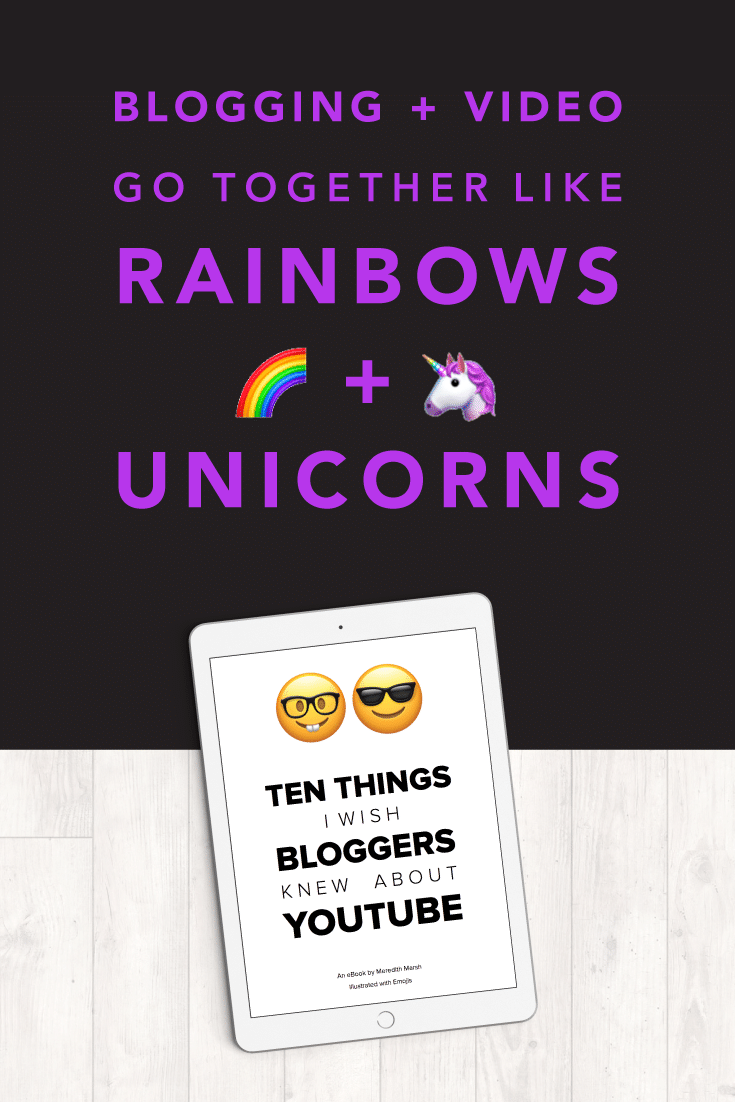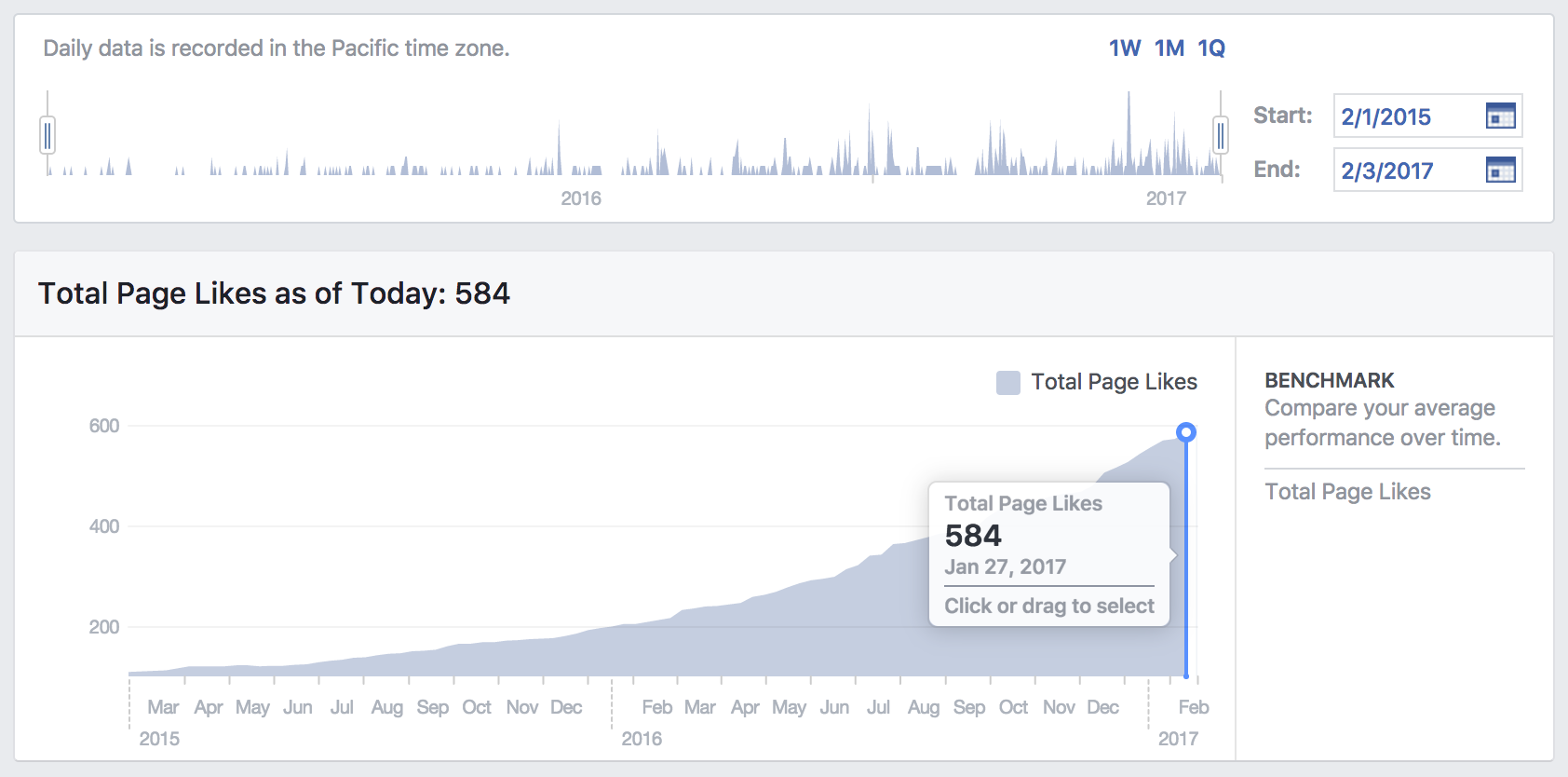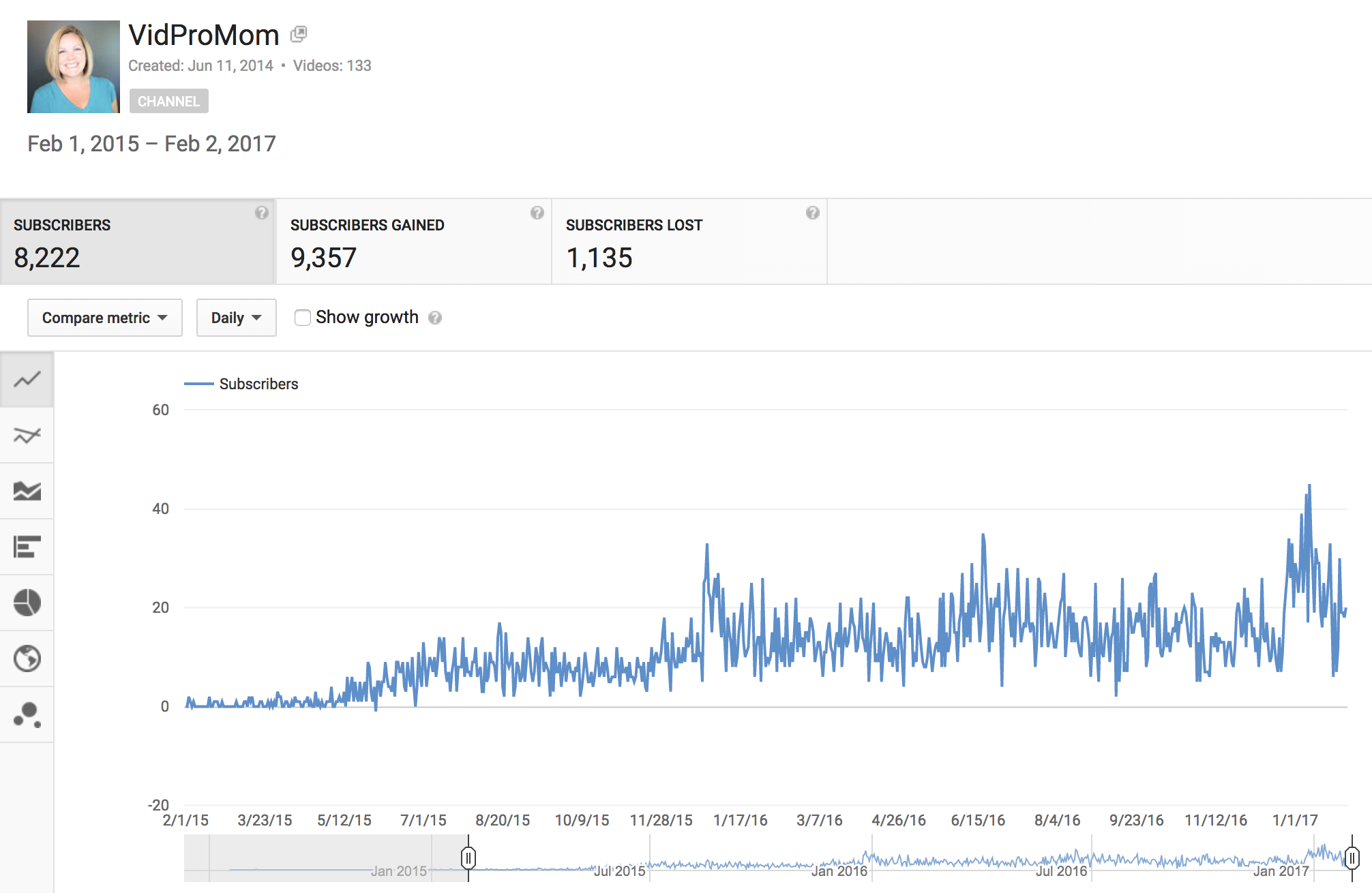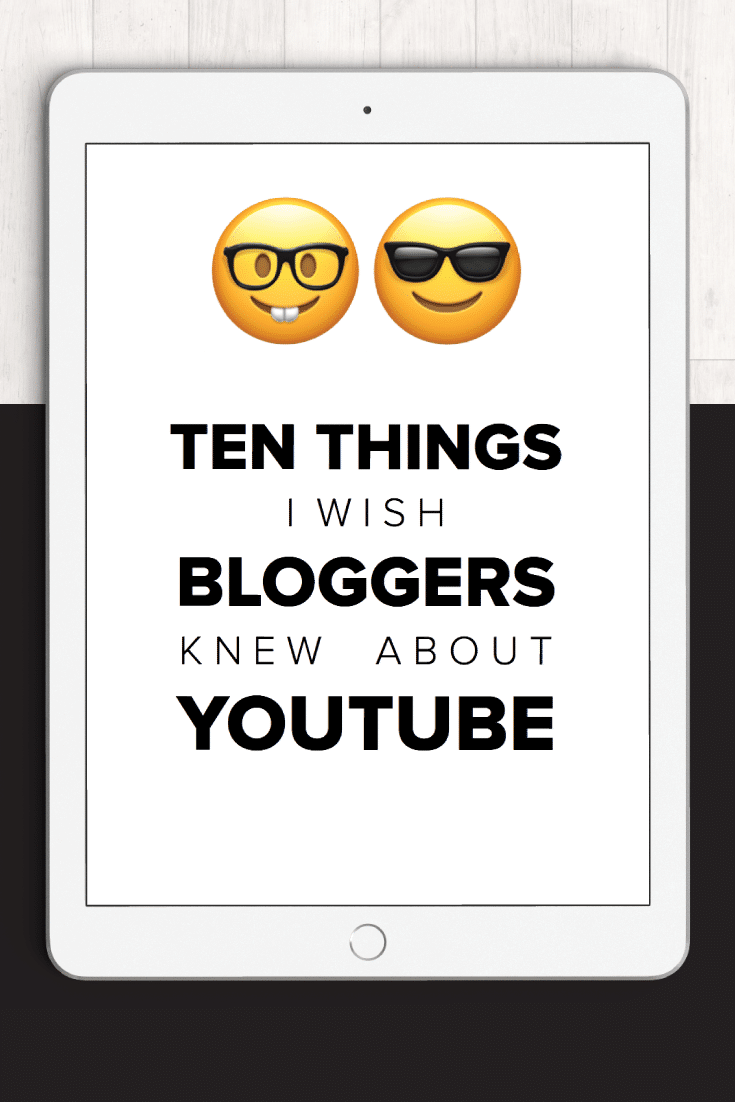10 Things I wish Bloggers Knew about YouTube
When I started publishing weekly blog posts and videos in January 2015, I thought I knew what I was getting into. I knew a ton about the technical side of WordPress, a ton about keyword research and a ton about creating content. But I didn’t know that almost my entire audience growth would take place on YouTube.
For the past two years, I have published weekly content on the VidProMom YouTube channel and on my blog at vidpromom.com. I teach “everyday” people (like you and me) how to create fun-to-watch GoPro videos, hobby videos, and family movies, and I like to cover other “tech stuff” as well.

Blogging and video (specifically YouTube videos) go together like unicorns and rainbows. I’ve personally seen the connection made when my website and video content work together like BFFs. Here’s something I notice about bloggers and YouTubers, though. Some bigger bloggers that I know are getting tons of website traffic but their videos (if they do them) don’t get many views. On the flip side, I notice that some bigger YouTubers I know are getting a ton of video views but they’re seeing little traffic to their site.
I see growth and engagement on both platforms… which is awesome. But it got me thinking about what I’m doing to make that happen for myself. I must be doing something right!? So let’s dive into 10 things I wish other bloggers knew about YouTube (whether you love it, hate it, or just aren’t sure about it…).
1. YouTube is Google
Let’s start with the most obvious thing. You likely already know that Google owns YouTube, but that alone is an understatement. YouTube is Google. When anyone does a search on Google, Google looks for results on websites and blogs, but it’s also looking for video results on YouTube.
It is known that YouTube is also the second largest search engine in the world. What that means is beside straight-up Googling stuff, people go to YouTube to search specific terms.
2. You might hate it
“I don’t want to be a YouTuber.”
I’ve heard that sentence more times than I can count from my blogger friends and within the multitude of Facebook groups I’m in.
The truth is… I said it too.
You might be thinking, “uh, is she trying to convince me to do video or not to do video?” and you’re totally right to wonder where my head’s at. Well, you’re half
Well, you’re half right. I’m not trying to convince you of anything, though. I don’t think you need convincing… you’re a blogger, so you’re a starter, an action-taker, and you’re a baller at creating content. I don’t need to convince you to try adding video into your content mix. Only you can do that.
Let me explain my thought process on why I felt I needed to create videos when I started what is now VidProMom.
Because of my topic (teaching people how to create GoPro videos, hobby videos, and family movies), I knew I’d need to do more than publish blog posts. Just words on a page wouldn’t work to deliver my message. Can you imagine reading through steps on how to get started using a particular piece of software and trying to grasp the concept? Yikes! It was obvious to me that video tutorials and how-to’s were going to be a necessity for my content.
I could have half-assed it. I could have done the bare minimum and just created screencast tutorials to go along with my weekly blog posts. I could have stayed in my comfy clothes and yesterday’s makeup and never put my face on camera at all. It would have saved a TON of time, a TON of anxiety, and a TON of money (ok, not a TON–I already had a nice camera because I love photography).
But… I would have helped a fraction of the people I have at this point.
Sooo… why did I? Is that what you’re wondering?
I was inspired by (then) stranger, (now) mentor and friend, Amy Schmittauer, of Savvy Sexy Social and Vlog Boss fame. I found her YouTube Channel, binged on her videos, and thought, “I can do that.” And so, I did.
I set up my camera near the windows of my living room. I used my phone to record my audio (if you’re wondering where I put the phone so that it was close enough to my mouth to catch my audio, that’s a cleavage story for another day). I recorded my intros and outros with my face on camera. Some of my first videos weren’t tutorials, it was just me talking to the camera. I was comfortable with Adobe Premiere Pro, so I edited my videos with that.
Guess what, you guys? GUESS. WHAT. Poor sound quality, horrible lighting, awkward intros, all that… and people subscribed. Liked. Commented. Asked for more.
And so, a YouTuber was born.
I’m telling you this because “I don’t want to be a YouTuber” is not a valid excuse to ignore video.
That’s not to say that once you try it, you’ll love it like I do.
In this book’s introduction, I wrote that blogging and video go together like unicorns and rainbows. I could have written that they go together like Ritz crackers and Nutella. If you’re into that combination (like me), then you’re reeeeeally into it. But if you’re not into it, you’re reeeeeeeally not into it and it probably sounds disgusting to you.
Video is not for everybody, but neither is blogging. If you haven’t tried… really tried… it’s high time to join the party.
3. You already have every single skill you need
While I started my online business, I was working in a semi-corporate environment managing web marketing for a company who eventually moved to another state and eliminated my job (did I really fit all that into one sentence?!).
Before that job, though, I was a freelance web designer. I worked with clients–mostly locals who were business owners, non-profits, and brick and mortars–who needed basic websites set up. I was a WordPress warrior (still am), design nerd (still am), coding geek (still am), and photography enthusiast (still am).
So when I started rolling around the idea of an online business model the involved a blog and videos, I kept thinking, “I have every single skill I need to make this work.” I literally could NOT think of one thing that I couldn’t do (or wasn’t at least interested in learning) that could keep me from being successful.
As a blogger, you have all the skills you need to create videos and upload to YouTube. Think about it… you learn new technologies ALL. THE. TIME. Next week, or next month, or next year, a new social media platform is going to gain momentum and you’re going to figure out how to leverage it. Facebook is going to release some new functionality, and you’re going to jump on it.
Imagine the year is 2010 and you’re a food and recipe blogger. Pinterest just launched, and you say “nah, I don’t want to be on Pinterest. I don’t have time to learn a new platform. I have to make sure my images’ alt descriptions are coherent now? BAH!! Too complicated!” Back then, food bloggers either embraced it real quick or they’re likely not a food blogger today.
EVEN IF you don’t know how to edit videos… EVEN IF you don’t know how to feel comfortable talking to a camera… EVEN IF you have little ones at home and you “can’t possibly record videos with them around”… you have the capacity and the drive to learn. You already proved it by reading this blog post.
4. You’re already doing half the work
…and get this: it’s the MOST IMPORTANT half.
It’s pretty common to assume that shooting is the most important part of making videos. That’s probably why we get hung up on things like “Oh no! I don’t have a fancy camera! I can’t possibly create a video!” (think again, honey, you have a smartphone).
But pre-production is a huge part of making successful video content. It doesn’t matter whether it’s for YouTube, Facebook, or live stream. The more you prep, the better the content will be (and the quicker it is to edit your video, too).
There are two different methods I use when I create videos:
Method 1: I write out a couple bullet points in Asana (the app I use for project management and all the things), I set up my camera, and I talk to it. I sound like this: Hey this is Meredith and today I want to… WAIT. STOP. How do I want to phrase this point? Re-start. WAIT. Let me start over.”
There is nothing wrong with this method, except everything. It’s frustrating, it takes longer to shoot, it takes WAY longer to edit, and it makes me anxious. I get all hot and sweaty with the camera and lights on me, trying to think on the fly like that.
Method 2. I open Asana and write paragraphs of text, including an intro and outro. I cover all the bullet points I need to cover, and usually write more than I really need to, to get the message across. Then I set up my camera and open Asana on my iPhone. I memorize a few sentences, then look up and talk to the camera. Memorize a few more sentences, and talk to the camera. And repeat.
This method takes less time in front of the camera (which saves on battery life, memory card space, and eventually hard drive space). It also takes less time editing and is much less stressful. This method ultimately leads to a well-produced piece of video content.
But that’s not all.
Do you notice that Method 2 sounds a lot like writing a blog post? When I’m done recording, editing, and uploading, all I have to do is copy and paste my script into WordPress, add links, images and BOOM: Blog post and video DONE.
5. If brands LIKE you as a blogger, they’ll LOVE you as a blogger on video
In my content calendar, I had planned to do a review of my Diva Ring Light during the first quarter of 2017. When I saw that the manufacturer was looking to sponsor YouTubers to review the product in a video, I was like, uh HELLO!
If you’re a blogger who has worked with brands on sponsored content, then you probably love that feeling of getting paid to talk about something you probably would have talked about for free. Right? Who wouldn’t?!
In Episode 10 of The VidPro Studio Show, I interviewed Jenny Ingram from Jenny On The Spot. She is a loooong, long-time blogger who has been incorporating video into her mix of content for a couple of years. Here’s what Jenny had to say about working with brands when you’re a blogger who is willing to create a video or go on camera:
“Most of my work comes from them coming to me, and it’s usually through a PR firm… a lot of times it’s been with PR companies I’ve worked in the past with… and they’ve become aware that I do video, and not everybody does, and so I think once you become known as somebody who’s willing to be in front of the camera, or have that ability to create something for the camera, then I think it opens up more opportunities for them to come to you.”
I mean… need I say more?
6. You may grow an audience on YouTube faster than you can on Facebook
I don’t want to make any sweeping generalizations here, but I am a data nerd so let’s look at some numbers. Since the start of my business, I’ve posted weekly on YouTube and at least weekly on Facebook (usually more).
On my YouTube channel, I upload my video, put in my title, description, tags, and upload the custom thumbnail. Once.
On my Facebook page, let’s see… I have:
- Posted an image with link to my video or blog post
- Posted just a text status
- Posted a text status with a link
- Posted a link with a thumbnail
- Posted full videos
- Posted teaser videos
- Done Facebook Live videos on my page
- Done Facebook Live videos in my groups
ALL. THE. THINGS. I know you know what I mean.
At the time of writing the eBook this post is adapted from, I had 594 Facebook Page Likes and 8,290 YouTube Subscribers.
See the screenshots here… I’ll let my data speak for itself.


Your experience may be different, of course. You might be crushing it on Facebook. It depends on your topic, your style, and your audience. But if you’re feeling the struggle with Facebook… it might be worthwhile to consider YouTube as a new platform.
7. Speaking of audiences… audiences are different.
The audiences you attract on your blog, Facebook page, Facebook group, YouTube channel, Twitter, etc. are different. They consume content differently. They want to consume your content differently.
Many bloggers post the same exact content across many platforms because it’s easy. You take your featured blog image and upload that to Instagram with a “link in the bio!” caption. Right? This isn’t an blog post about Instagram so I’m not going to be the one to tell you that’s likely not what your Instagram followers want to see. But, ok, I said it.
I used to do the same thing with YouTube and Facebook: I would upload the same video to Facebook that I uploaded to YouTube.
In episode 2 of my podcast, I talked with Julie Golob and she mentioned that she treats her YouTube and Facebook audiences completely different (and she has a HUGE Facebook audience).
“It’s all about the audience… decide what you want to focus on and make sure that they’re happy… the YouTube community are generally not Facebookers or Twitter people. They’re there because they love YouTube. And the ones that are the most active… the people that are commenting on your channel and your videos, they’re there because they searched for you or they found you because you are similar to someone else that they really like. On Facebook, it’s more of a network for friends and family… I know that those people are connecting that way with people, so it’s a completely different audience.”
8. Your blog post and video don’t have to be twinsies
Let’s back up to where I said you’re already doing half the work already. The type of video that you add to your content mix depends on a lot of things.
I think videos and blog posts do perform well together when they compliment each other. If that means your blog post is essentially your video script (what I often do, with some images and links popped in), then great. If that means you write a blog post and then create a how-to video featuring just one point of your post, then great. If you post a blog post with
For example: If you post a blog post with a recipe, where the reader needs to do something strange and new with an ingredient, like poaching an egg for example, maybe you do a video on just that part: How to Poach an Egg.
How you choose to compliment your blog posts with videos (and vice versa) will depend on your topic, and it’s okay to be matchy-matchy if that’s what makes sense. Just remember, your audiences are different on your different platforms.
9. You like Adsense income, right?
Do I even have to write a section on this? If you monetize your blog with Adsense ads (or any CPM ads), I’m here to tell you that you can monetize your videos with Adsense as well. Need I say more?
10. Everyone else is a scaredy cat, so step up
When I was in 8th grade, I joined my school’s track team. I hated running and hated participating in sports, but my friends were on the team and I caved to the peer pressure.
When it was time to divvy up the events among my teammates, no one wanted to do the triple jump. The coach demonstrated this awkward style of long jump and everyone said “yeeeaaaa NO, I’m not doing THAT”.
I raised my hand.
I saw everyone else’s fear as a challenge to step up (and I thought it would get me out of more of the running events, which it did, so mission accomplished).
Anyway, I learned the triple jump, and I’m sure I was never any good at it but I was the only girl on the team who knew how to do it.
At almost every single track meet we had that year, guess how many girls the opposing team had to do the triple jump? None. No one had the guts to do the triple jump.
Fear is powerful. It’s how we know we’re alive. It’s how we know we’re growing.
Before you suspect that I’m going to go all Tony Robbins on you and tell you how you can use that fear to conquer your dreams, think again.
He’d be right, but let me offer you a different spin.
You can win by being the best or you can win by being the only one brave enough to compete.
Right now, all you need is to be is brave enough to compete.
Everyone else is afraid of video. They don’t have time to do it. They “don’t want to be a YouTuber”. They don’t want to do the work.
They don’t want to reap the rewards. They don’t have to, but you can.
I dare you.
I feel very passionate about helping other bloggers discover things about themselves that they never knew were there… because I never dreamed of “being a YouTuber,” and yet here I am telling that it has made a monumental difference in the building of my brand and the start of my business.
I’d love to hear from you in the comments… what’s your hangup with triple jumping into YouTube?
This post is adapted from an eBook I wrote by the same title, which you can download for free, right here.

